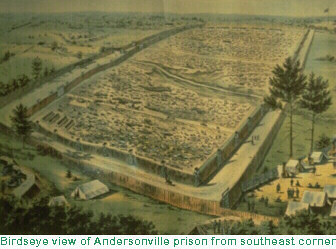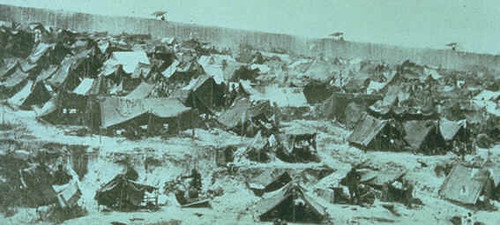Andersonville
Seeing the scenes of absolute horror at the New Orleans Riverwalk and Convention Center, I'm reminded of nothing so much as the Confederate prison for Union soldiers during the Civil War in Andersonville, Georgia.

Here's an excerpt from a historical record, as a refresher course:
Arriving in late December of 1863, Captain Winder adopted a prison design that encompassed roughly 16.5 acres which he felt was large enough to hold 10,000 prisoners. The prison was to be rectangular in shape with a small creek flowing roughly through the center of the compound. The prison was given the name Camp Sumter.
Prisoners began arriving at the prison in late February of 1864 and by early June the prison population had climbed to 20,000. Consequently, it was decided that a larger prison was necessary, and by mid-June work was begun to enlarge the prison. On July 1, the northern extension was opened to the prisoners who subsequently tore down the original north stockade wall, then used the timbers for fuel and building materials. By August, over 33,000 Union prisoners were held in the 26.5 acre prison.
Due to the threat of Union raids (Sherman's troops were marching on Atlanta), General Winder ordered the building of defensive earthworks and a middle and outer stockade around the prison. Construction of the earthworks began July 20th. These earthworks consisted of Star Fort located southwest of the prison, a redoubt located northwest of the north gate, and six redans.
During the 15 months during which Andersonville was operated, almost 13,000 Union prisoners died there of malnutrition, exposure, and disease; Andersonville became synonymous with the attrocities which both North and South soldiers experienced as prisoners of war.
They died because 1) there was not enough food provided to the prisoners, and 2) the water became polluted and disease-ridden. The parallels are shameful.
Here's another essay that includes some first-hand accounts:
On one particularly hot July evening that year, a Confederate guard from the 26th Alabama regiment stood watch on the parapet of the stockade prison, which was more commonly referred to as Andersonville Prison by the locals, and as “hell” by the Union soldiers and sailors incarcerated there.
The prison was nothing more than acres of open ground surrounded by a stockade fence and earthworks barricades. The destitute prisoners sheltered themselves as best they could, some with makeshift tents, others in shallow holes dug in the dirt, lined with pine needles, and covered with whatever scrap of fabric the men had—a tarp, a blanket, maybe a tattered coat. The prison was so crowded that each man had just enough room to lie down.
As dusk gave way to night, the guard looked out on thousands of prone, wretched bodies—some of them nearly skeletons from dysentery and malnourishment—and he thought of Andersonville as a massive graveyard where the corpses were still breathing and graves were yet to be covered.
Similar to the stories of maternity wards in NOLA is this story of a baby at Andersonville:
The guard from Alabama could hear the prisoners below him. But tonight the guard thought he heard something else. He thought he might be going crazy, but he’d heard the same sound that morning and the night before as well. It sounded like the cries of a newborn.
He scanned the terrain of bodies and squinted through the gloom. A baby in this hell hole? he thought. The Lord could never be so cruel.
He heard a series of high-pitched, plaintive wails that carried over the din, and now there was no doubt in his mind that there was a child down there. The silhouette in skirts swayed faster, bouncing the bundle on her shoulder. The guard didn’t like this development at all. He feared for their safety. A horrible thought passed through his mind—the emaciated prisoners falling upon this child for food. His heart was thumping hard. He had to tell someone about this immediately.
This link mentions prisoner conditions:
The prisoners daily ratio of food consisted of one and one-forth pound of corn meal and either one pound of beef or one-third pound of bacon. They occasionally got sme beans, peas, rice, or molasses with it.
Conditions at the prison were initially good. Deaths of prisoners were not common during the initial months. Prisoners died from all different things like; overcrowding, disease, and exposure.
No clothing was provided, many people were left with rags or fragments of clothing. Some had nothing at all. Their daily food ratio consisted of one and one-fourth pound of corn meal and either one pound of beef or 1/3 pound of bacon. The prisoners occasionally got some beans, peas, rice, of molasses with it.
Here's a daguerrotype of the camp:

There's little doubt that we could be looking at the same kind of loss of life if we don't act fast. The shining jewel of the Southeast is now Andersonville Prison.






<< Home